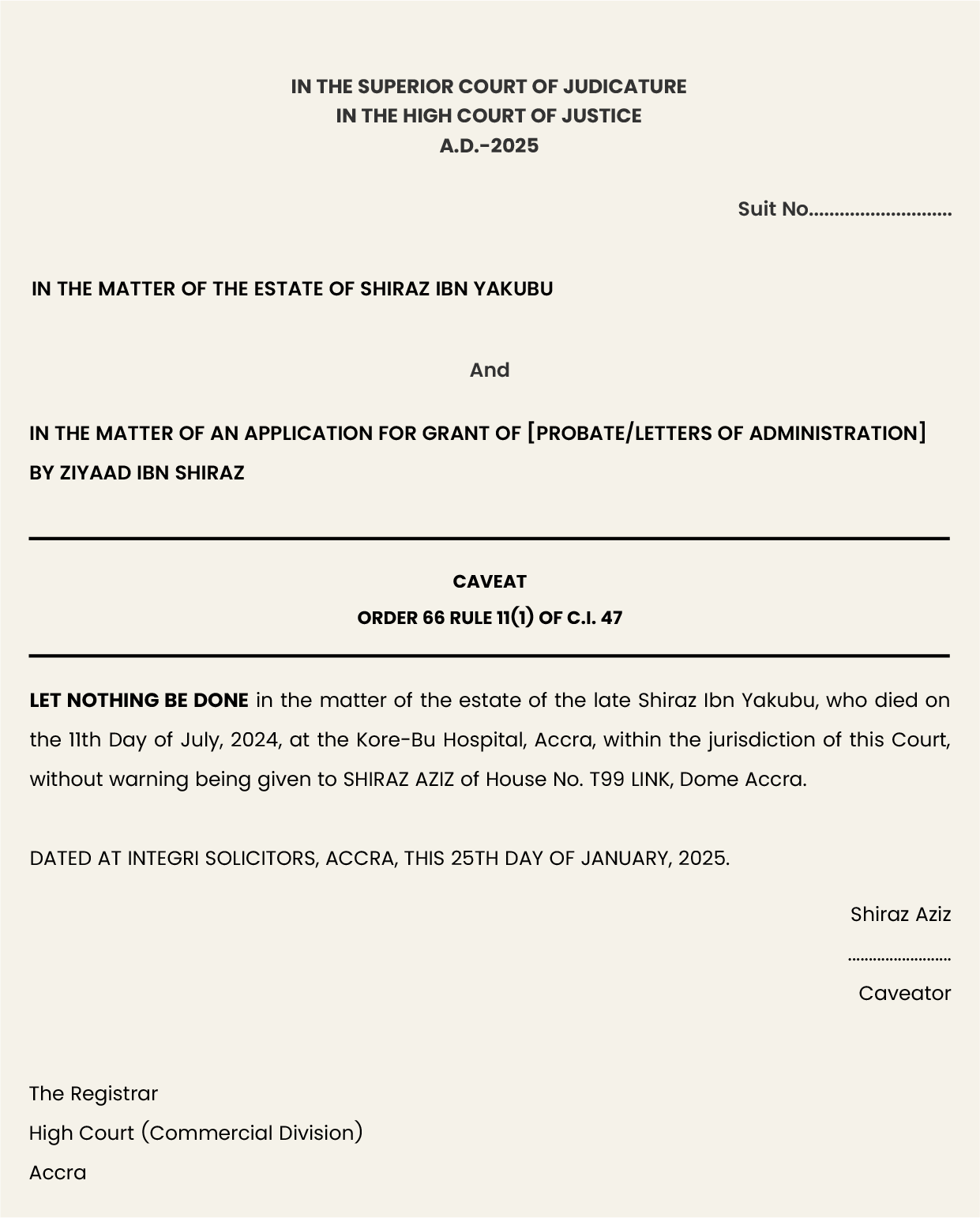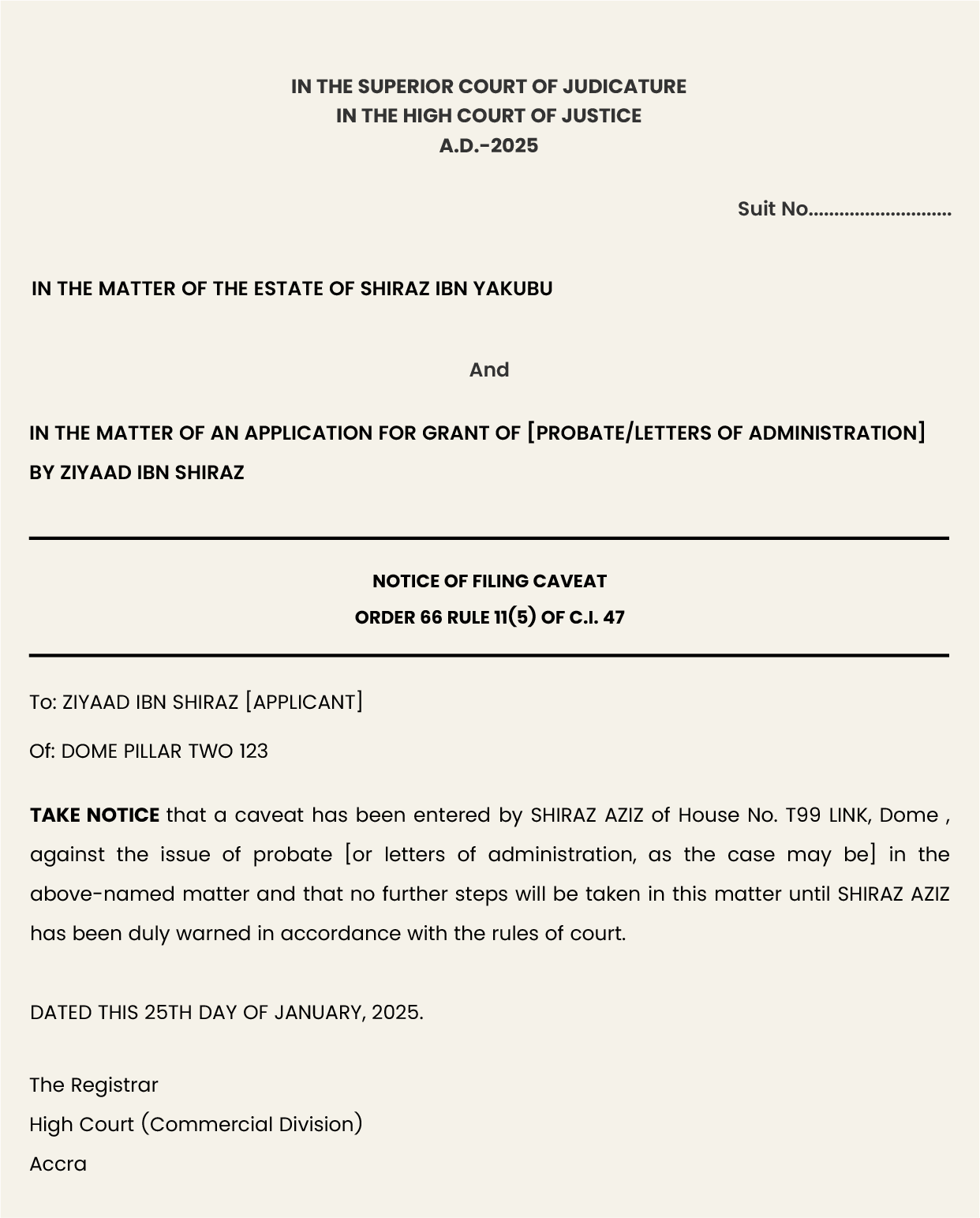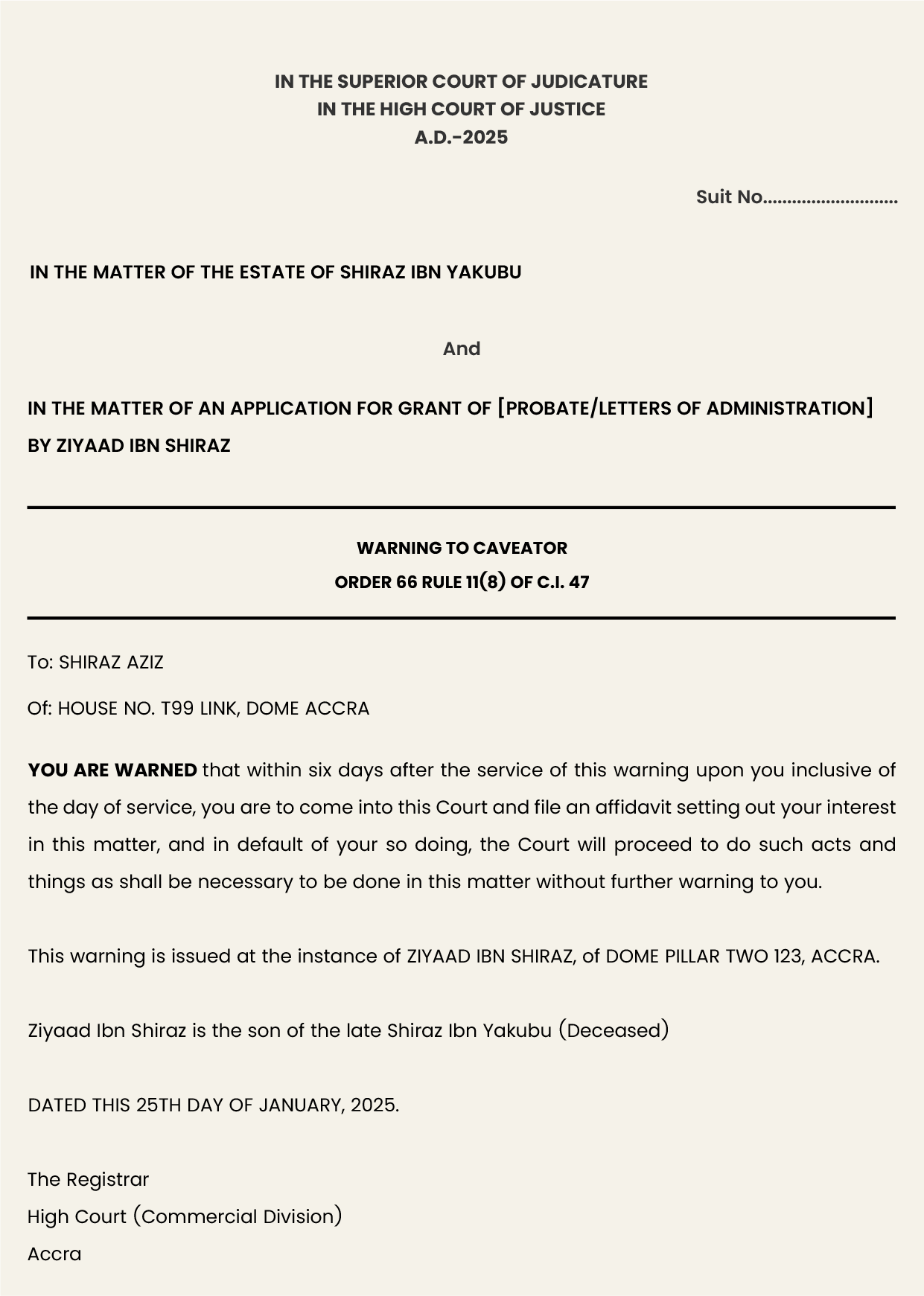Note on Caveat by Legum
Caveat
Introduction:
This note will discuss the meaning of a caveat in the context of a probate action, its effect, the fact that it is not used in challenging the validity of a will, its duration, when it may be filed, the duties it places on an applicant upon being brought to his notice, the subsequent duties it places on a caveator (the person who filed a caveat), the effect of a caveator discharging or failing to discharge those duties, and what happens after a caveator is given notice of the moving of a motion for the grant of probate or letters of administration.
Meaning of a Caveat:
Per Order 66 Rule 11(1) of the High Court (Civil Procedure) Rules, 2004 C.I. 47 ,
Any person who has or claims to have an interest in the estate of a deceased and who wishes to ensure that no grant of probate or letters of administration is issued without notice to the person, may file a caveat as in Form 24 specified in the Schedule.
From this provision, it may thus be said that a caveat is a process filed by a person who claims an interest in the estate of a deceased and who wishes to be given notice before there is any issue of a grant of probate or letters of administration.
The word caveat is of Latin origin and means “"let him or her beware.” It may also be said that when a person files a caveat, he is asking to be made aware before the court actually issues the grant of probate or letters of administration to any person.
Below is a sample of a caveat:

A Caveat is not Used to Challenge the Validity of the Will:
To further clarify the meaning and effect of a caveat, note that a caveat is not a process by which the validity of a will is challenged but simply a process by which a person requests to be notified before there is an issue of a grant of probate or letters of administration. This was explained in the case of Kofigah and Another v. Atanley and Another [2020] GHASC 10 (22 January 2020) . In that case, the plaintiff filed a caveat against the grant of probate. When they were asked to disclose their interest and the grounds for the caveat, they filed an affidavit by which they swore that the signature on the will is not that of the deceased and that the will ought to be cancelled or annulled. The Supreme Court stated that challenging the validity of a will via a caveat was procedurally flawed. In the words of their lordships,
Having regard to the above depositions in the affidavit, the filing of the caveat was a false procedural step since by Rule 11 of Or 66 of the High Court (Civil Procedure) Rules, 2004 (C.I.47), the filing of a caveat against grant of probate or letters of administration is for the court to determine the proper persons to be appointed executors or administrators and not for the purpose of challenging the validity of a Will. Under the Rules, the procedure by which the validity of a Will may be challenged is different and it will be discussed in the course of this opinion.
…
Where any person challenges the validity of the Will, she has two alternative ways of proceeding under the Rules. She may file a notice pursuant to Rules 26 of Or 66 calling on the executors to proof the Will in solemn form or to renounce probate. Executors prove a Will in solemn form by issuing a writ of summons against the person calling for it to be proved and praying the court to declare the Will valid.
…
The alternative method is for the person challenging the validity of the Will to issue a writ of summons pursuant to Rule 28 (1) of Or 66 against the executors praying the court to declare the will invalid. The Rule is as follows; “28. (1) Any person who claims to have an interest in the estate of a deceased testator may, instead of issuing a notice to the executor to prove the will under rule 26 (2) of this Order, bring an action against the executor for a declaration that the will is invalid.”
Duration of a Caveat:
Per Order 66 Rule 11(6), “A caveat shall remain in force for three months from the date on which it is filed, but may be renewed from time to time.”
When a Caveat Can Be Filed:
In Order 66 Rule 11(3), it is provided that the caveat may be filed before or after an application is made for probate or letters of administration. It provides that an application cannot be made after the grant.
A caveat filed before an application is in the nature of a pre-emptive caveat. It ensures that at anytime any person applies for letters of administration, the caveator will be given notice. Upon the filing of such a caveat, the caveat is kept by the Registrar and only brought to the notice of the court as soon as an application is filed.
On the other hand, if the caveat is filed after an application for probate or letters of administration has been made, the Registrar must bring it immediately to the notice of the court in which the application is made. Here, there is no need to wait, as there is already a pending application, and the caveat needs to be taken into account.
In Order 66 Rule 11(7), a duty is placed on the Registrar to not allow any grant of probate or letters of administration to be sealed if he has knowledge of an effective caveat in respect of the grant. However, if the caveat was filed on the day the grant was to be sealed, it cannot operate to prevent the sealing of the grant.
Duty of the Court upon being Given Notice of a Caveat by the Registrar:
In Order 66 Rule 11(5), it is provided that:
On being given notice of a caveat [by the Registrar], the Court shall direct the Registrar to bring it to the notice of the applicant or the lawyer of the applicant as in Form 25 in the Schedule and shall decline to take any further steps until the applicant duly warns the caveator.
Here, the duty of the court is two-fold:
1. Duty One: Direct the registrar to bring the caveat to the notice of the applicant or his lawyer. Below is a sample of such a notice:

2. Duty Two: Decline to take any further steps until the applicant warns the caveator(the person who filed the caveat). What amounts to warning the caveator is now discussed.
Meaning of Warning the Caveator:
Per the provision of Order 66 Rule 11(8), it may be said that a warning is a process by which an applicant for probate or letters of administration, upon being given notice of a caveat, requests the person who filed the caveat, known as the caveator, to file an affidavit stating:
i. The nature of his interest in the estate of the deceased.
ii. The particulars of his interests in the estate of the deceased.
The warning is issued by the Registrar at the instance of the applicant.
Below is a sample of a warning:

Duties Placed on the Caveator Upon Being Warned and Consequences of Discharging or Failing to Discharge the Duties:
Upon receiving the warning, the caveator is expected to file the affidavit stating the nature of his interest. He may or may not obey this warning. There are different consequences for each action or inaction taken by the caveator.
If the caveator does not obey the warning, subrule 9 of rule 11 provides that “the applicant shall move the Court in respect of the applicant's original motion for the grant of probate or letters of administration and where the Court considers it fit it shall direct that notice be served on the caveator.” Notice the discretion given to the court here to direct that notice of the motion being moved be served on the caveator.
On the other hand, if the warning is obeyed, thus if the caveator files the affidavit stating his interest and the particulars of his interest, sub rule 10 provides that a copy of the affidavit be served on the person applying for the probate or letters of administration. Subsequently, the applicant “shall then move the Court to grant probate or letters of administration on notice to the caveator who shall at the expense of the applicant, be served with copies of any affidavits on which the applicant intends to rely.” Notice the absence of discretion here, as the applicant is mandated (shall) to move his motion on notice to the caveator.
What Happens at the Hearing after Notice is Given to the Caveator?
If at the hearing of the motion the parties agree on the person to whom probate or letters of administration should be granted, the court can order the removal of the caveat and make a grant of probate or letters of administration to that person.
If there is no such agreement between the parties, the following may happen:
i. The court can summarily determine who is entitled to a grant of probate or letters of administration.
ii. The court may order that the applicant for the grant of probate or letters of administration issue a writ against the caveator within 14 days from the date of the order. This is to enable the court determine who is entitled to grant of probate or letters of administration.
Speed
1x